KIA Sorento 2009 2.G Owner's Guide
Manufacturer: KIA, Model Year: 2009, Model line: Sorento, Model: KIA Sorento 2009 2.GPages: 327, PDF Size: 5.03 MB
Page 21 of 327
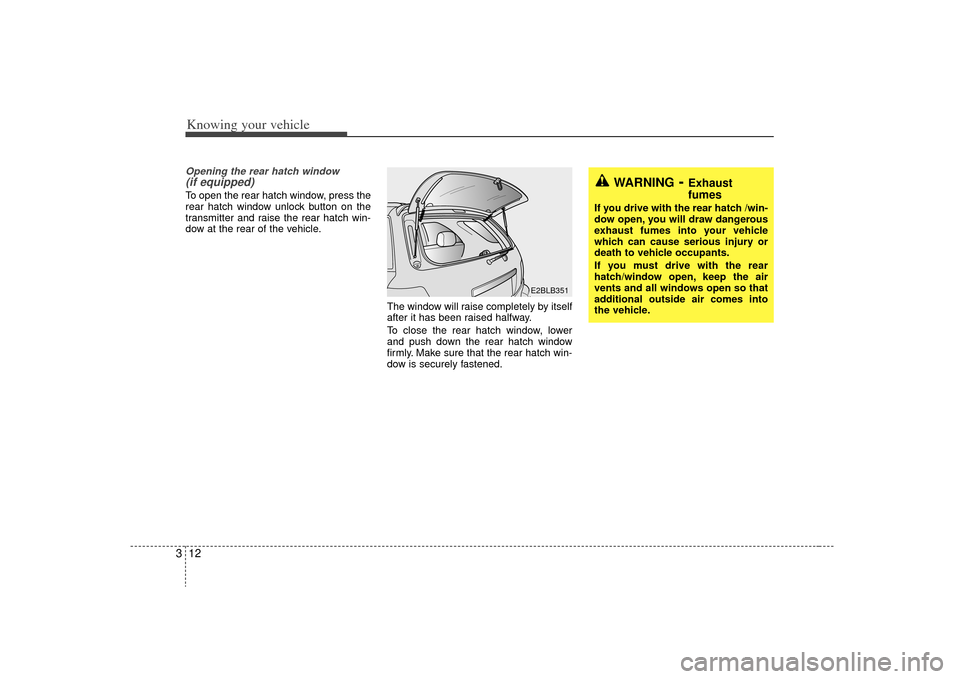
Knowing your vehicle12
3Opening the rear hatch window(if equipped)To open the rear hatch window, press the
rear hatch window unlock button on the
transmitter and raise the rear hatch win-
dow at the rear of the vehicle.
The window will raise completely by itself
after it has been raised halfway.
To close the rear hatch window, lower
and push down the rear hatch window
firmly. Make sure that the rear hatch win-
dow is securely fastened.
WARNING
- Exhaust
fumes
If you drive with the rear hatch /win-
dow open, you will draw dangerous
exhaust fumes into your vehicle
which can cause serious injury or
death to vehicle occupants.
If you must drive with the rear
hatch/window open, keep the air
vents and all windows open so that
additional outside air comes into
the vehicle.
E2BLB351
Page 22 of 327
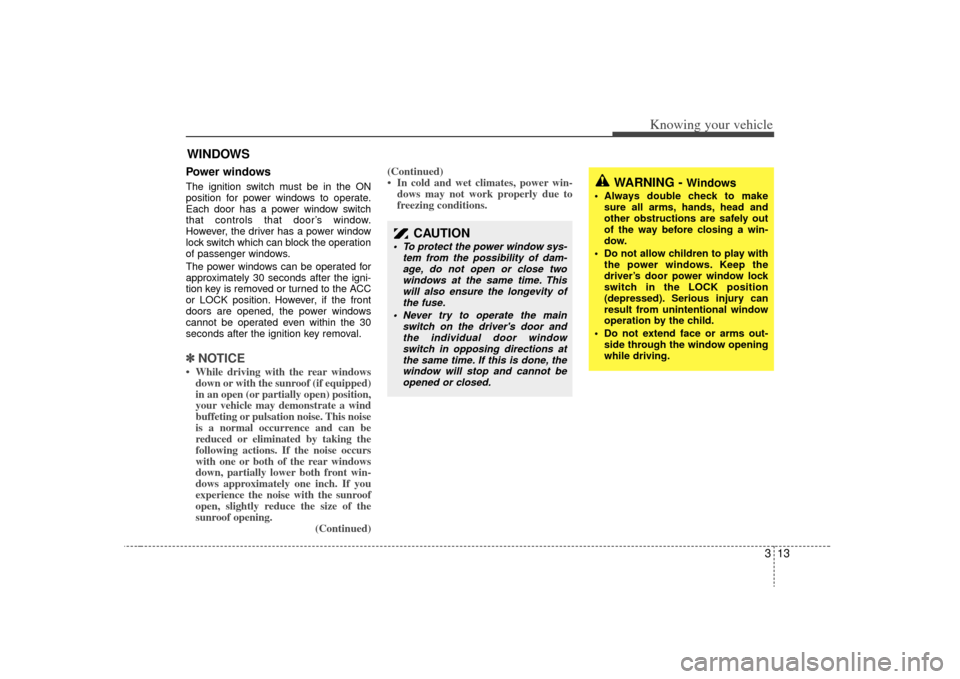
313
Knowing your vehicle
Power windows The ignition switch must be in the ON
position for power windows to operate.
Each door has a power window switch
that controls that door’s window.
However, the driver has a power window
lock switch which can block the operation
of passenger windows.
The power windows can be operated for
approximately 30 seconds after the igni-
tion key is removed or turned to the ACC
or LOCK position. However, if the front
doors are opened, the power windows
cannot be operated even within the 30
seconds after the ignition key removal.✽ ✽NOTICE• While driving with the rear windows
down or with the sunroof (if equipped)
in an open (or partially open) position,
your vehicle may demonstrate a wind
buffeting or pulsation noise. This noise
is a normal occurrence and can be
reduced or eliminated by taking the
following actions. If the noise occurs
with one or both of the rear windows
down, partially lower both front win-
dows approximately one inch. If you
experience the noise with the sunroof
open, slightly reduce the size of the
sunroof opening. (Continued)(Continued)
• In cold and wet climates, power win-
dows may not work properly due to
freezing conditions.WINDOWS
CAUTION
To protect the power window sys-
tem from the possibility of dam-age, do not open or close twowindows at the same time. This will also ensure the longevity ofthe fuse.
Never try to operate the main switch on the driver's door andthe individual door window switch in opposing directions atthe same time. If this is done, thewindow will stop and cannot be opened or closed.
WARNING -
Windows
Always double check to make sure all arms, hands, head and
other obstructions are safely out
of the way before closing a win-
dow.
Do not allow children to play with the power windows. Keep the
driver’s door power window lock
switch in the LOCK position
(depressed). Serious injury can
result from unintentional window
operation by the child.
Do not extend face or arms out- side through the window opening
while driving.
Page 23 of 327
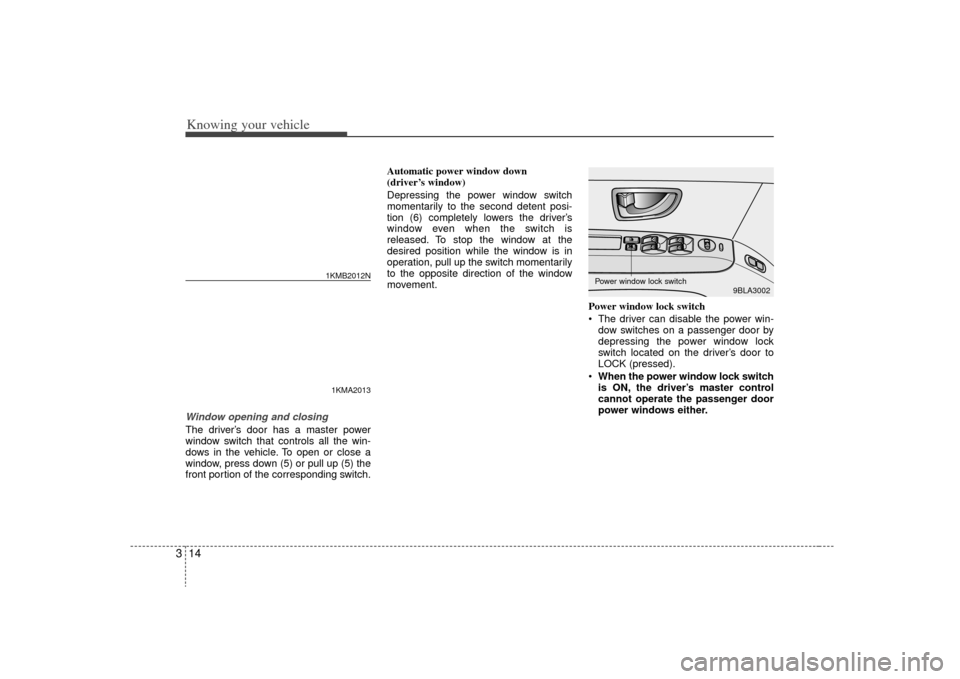
Knowing your vehicle14
3Window opening and closingThe driver’s door has a master power
window switch that controls all the win-
dows in the vehicle. To open or close a
window, press down (5) or pull up (5) the
front portion of the corresponding switch. Automatic power window down
(driver’s window)
Depressing the power window switch
momentarily to the second detent posi-
tion (6) completely lowers the driver’s
window even when the switch is
released. To stop the window at the
desired position while the window is in
operation, pull up the switch momentarily
to the opposite direction of the window
movement.
Power window lock switch
The driver can disable the power win-dow switches on a passenger door by
depressing the power window lock
switch located on the driver’s door to
LOCK (pressed).
When the power window lock switch
is ON, the driver’s master control
cannot operate the passenger door
power windows either.
1KMA2013
1KMB2012N
9BLA3002
Power window lock switch
Page 24 of 327
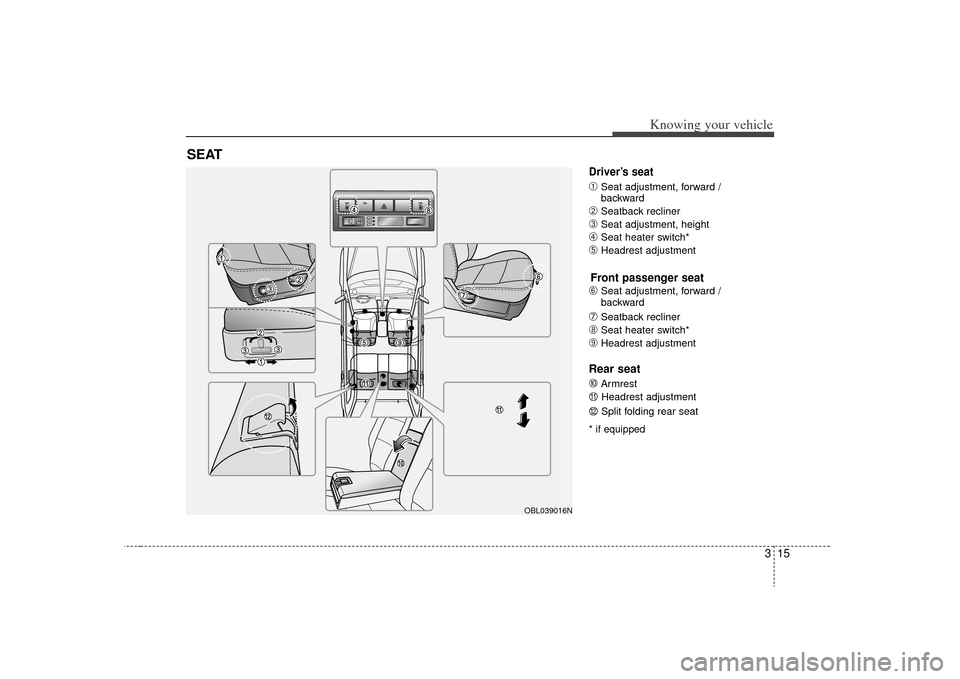
315
Knowing your vehicle
Driver’s seat➀
Seat adjustment, forward /
backward
➁
Seatback recliner
➂
Seat adjustment, height
➃
Seat heater switch*
➄
Headrest adjustmentFront passenger seat\b
Seat adjustment, forward /
backward
➆
Seatback recliner
➇
Seat heater switch*
➈
Headrest adjustment
Rear seat
\f
ArmrestHeadrest adjustment
Split folding rear seat
* if equipped
SEAT
1112
OBL039016N
Page 25 of 327
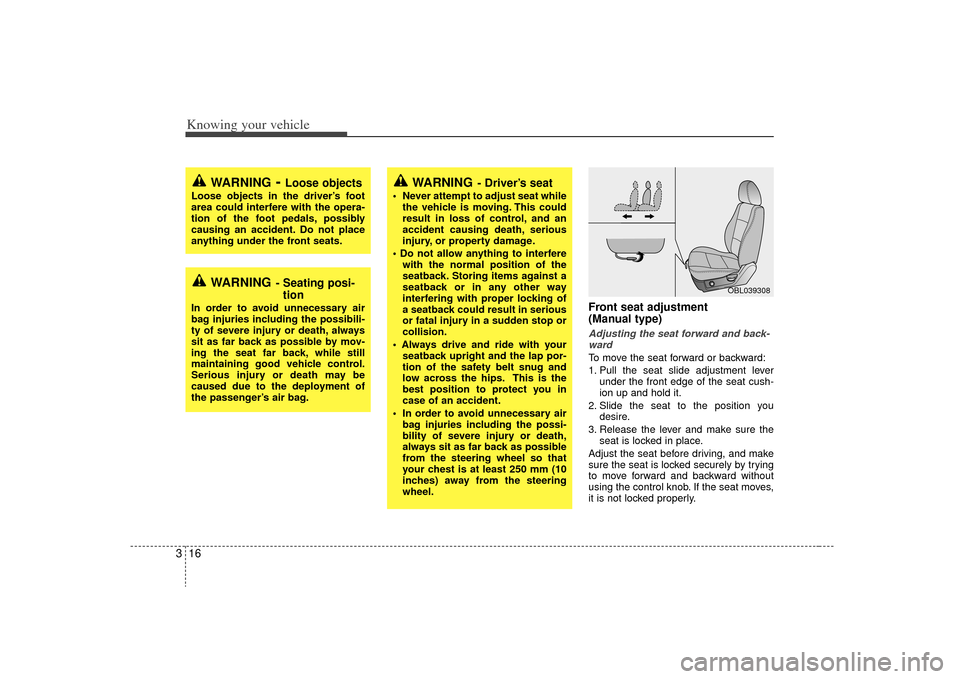
Knowing your vehicle16
3
Front seat adjustment
(Manual type)Adjusting the seat forward and back-
wardTo move the seat forward or backward:
1. Pull the seat slide adjustment lever under the front edge of the seat cush-
ion up and hold it.
2. Slide the seat to the position you desire.
3. Release the lever and make sure the seat is locked in place.
Adjust the seat before driving, and make
sure the seat is locked securely by trying
to move forward and backward without
using the control knob. If the seat moves,
it is not locked properly.
WARNING
- Loose objects
Loose objects in the driver’s foot
area could interfere with the opera-
tion of the foot pedals, possibly
causing an accident. Do not place
anything under the front seats.
WARNING
- Driver’s seat
Never attempt to adjust seat while the vehicle is moving. This could
result in loss of control, and an
accident causing death, serious
injury, or property damage.
with the normal position of the
seatback. Storing items against a
seatback or in any other way
interfering with proper locking of
a seatback could result in serious
or fatal injury in a sudden stop or
collision.
seatback upright and the lap por-
tion of the safety belt snug and
low across the hips. This is the
best position to protect you in
case of an accident.
In order to avoid unnecessary air bag injuries including the possi-
bility of severe injury or death,
always sit as far back as possible
from the steering wheel so that
your chest is at least 250 mm (10
inches) away from the steering
wheel.
WARNING
- Seating posi-tion
In order to avoid unnecessary air
bag injuries including the possibili-
ty of severe injury or death, always
sit as far back as possible by mov-
ing the seat far back, while still
maintaining good vehicle control.
Serious injury or death may be
caused due to the deployment of
the passenger’s air bag.
OBL039308
Page 26 of 327
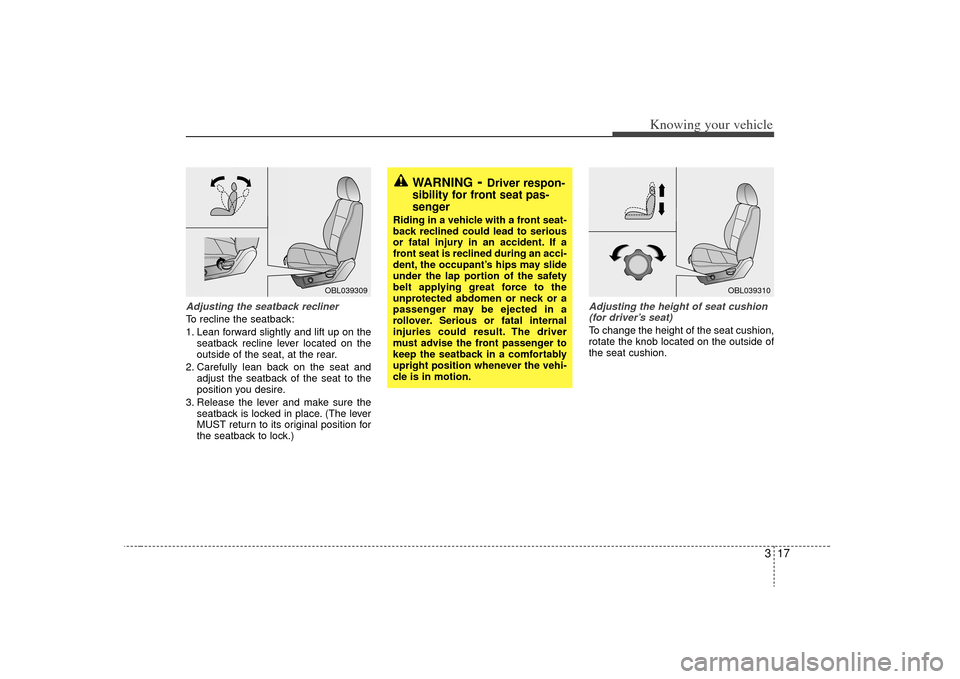
317
Knowing your vehicle
WARNING
- Driver respon-
sibility for front seat pas-
senger
Riding in a vehicle with a front seat-
back reclined could lead to serious
or fatal injury in an accident. If a
front seat is reclined during an acci-
dent, the occupant’s hips may slide
under the lap portion of the safety
belt applying great force to the
unprotected abdomen or neck or a
passenger may be ejected in a
rollover. Serious or fatal internal
injuries could result. The driver
must advise the front passenger to
keep the seatback in a comfortably
upright position whenever the vehi-
cle is in motion.
Adjusting the seatback reclinerTo recline the seatback:
1. Lean forward slightly and lift up on the
seatback recline lever located on the
outside of the seat, at the rear.
2. Carefully lean back on the seat and adjust the seatback of the seat to the
position you desire.
3. Release the lever and make sure the seatback is locked in place. (The lever
MUST return to its original position for
the seatback to lock.)
Adjusting the height of seat cushion(for driver’s seat)To change the height of the seat cushion,
rotate the knob located on the outside of
the seat cushion.
OBL039309
OBL039310
Page 27 of 327
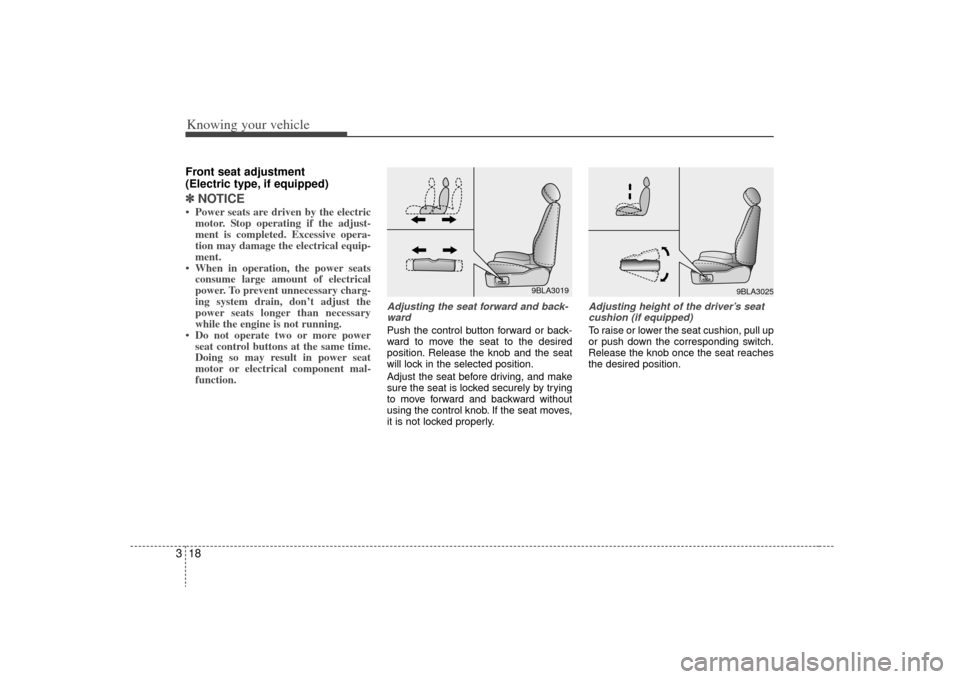
Knowing your vehicle18
3Front seat adjustment
(Electric type, if equipped)✽ ✽
NOTICE• Power seats are driven by the electric
motor. Stop operating if the adjust-
ment is completed. Excessive opera-
tion may damage the electrical equip-
ment.
• When in operation, the power seats consume large amount of electrical
power. To prevent unnecessary charg-
ing system drain, don’t adjust the
power seats longer than necessary
while the engine is not running.
• Do not operate two or more power seat control buttons at the same time.
Doing so may result in power seat
motor or electrical component mal-
function.
Adjusting the seat forward and back-
wardPush the control button forward or back-
ward to move the seat to the desired
position. Release the knob and the seat
will lock in the selected position.
Adjust the seat before driving, and make
sure the seat is locked securely by trying
to move forward and backward without
using the control knob. If the seat moves,
it is not locked properly.
Adjusting height of the driver’s seatcushion (if equipped)To raise or lower the seat cushion, pull up
or push down the corresponding switch.
Release the knob once the seat reaches
the desired position.
9BLA3019
9BLA3025
Page 28 of 327
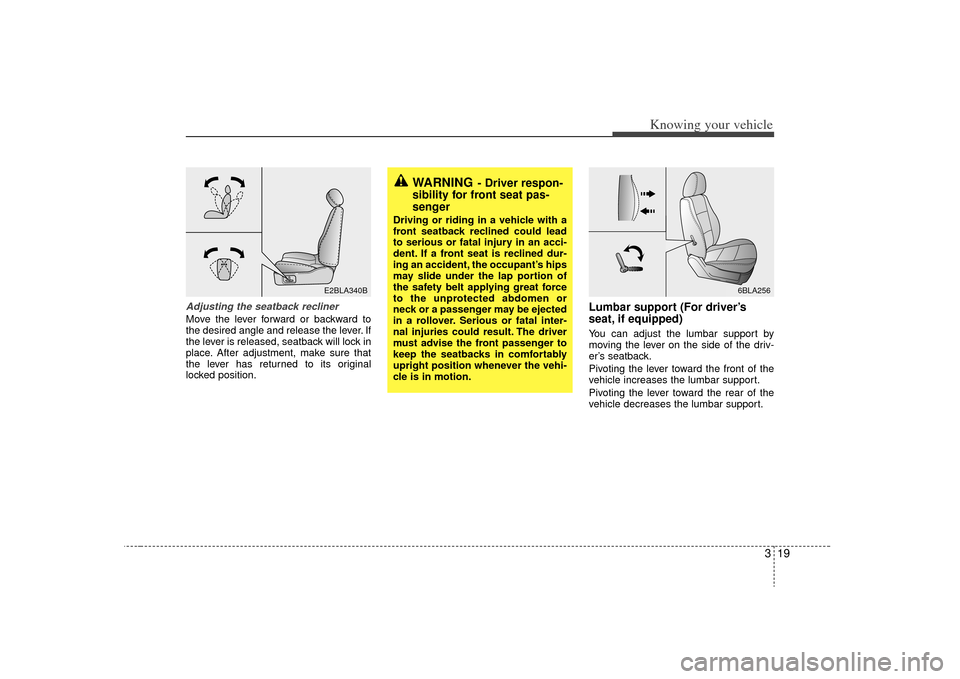
319
Knowing your vehicle
Adjusting the seatback reclinerMove the lever forward or backward to
the desired angle and release the lever. If
the lever is released, seatback will lock in
place. After adjustment, make sure that
the lever has returned to its original
locked position.
Lumbar support (For driver’s
seat, if equipped) You can adjust the lumbar support by
moving the lever on the side of the driv-
er’s seatback.
Pivoting the lever toward the front of the
vehicle increases the lumbar support.
Pivoting the lever toward the rear of the
vehicle decreases the lumbar support.
E2BLA340B
WARNING
- Driver respon-
sibility for front seat pas-
senger
Driving or riding in a vehicle with a
front seatback reclined could lead
to serious or fatal injury in an acci-
dent. If a front seat is reclined dur-
ing an accident, the occupant’s hips
may slide under the lap portion of
the safety belt applying great force
to the unprotected abdomen or
neck or a passenger may be ejected
in a rollover. Serious or fatal inter-
nal injuries could result. The driver
must advise the front passenger to
keep the seatbacks in comfortably
upright position whenever the vehi-
cle is in motion.
6BLA256
Page 29 of 327

Knowing your vehicle20
3Warming the front seats
(if equipped)The front seats can be electrically heated
individually when the ignition switch is
ON. When you depress the seat warmer
switch, a thermostat regulates seat tem-
perature. To deactivate the heating sys-
tem, depress the switch once again.✽ ✽
NOTICE• The seat warmer will not operate if
ambient temperature is above 37±3°C
(98.5±5.5°F).
• If the seat warmer doesn't work when the ambient temperature is below
28±3°C (82.5±5.5°F), have the system
checked by an authorized dealer.
OBL026002N
CAUTION
When cleaning the seats, do not
use an organic solvent such asthinner, benzene, alcohol and gasoline. Doing so may damagethe surface of the heater or seats.
To prevent overheating the seat warmer, do not place blankets,cushions or seat covers on theseats while the seat warmer is in operation.
Do not place heavy or sharp objects on seats equipped withseat warmers. Damage to the seat warming components couldoccur.
WARNING
- Seat heater burns
Passengers should use extreme
caution when using seat warmers
due to the possibility of excess
heating or burns. In particular, the
driver must exercise extreme care
for the following types of passen-
gers:
1. Infants, children, elderly or dis-
abled persons, or hospital outpa-
tients
2. Persons with sensitive skin or those that burn easily
3. Fatigued individuals
4. Intoxicated individuals
5. Individuals taking medication that can cause drowsiness or
sleepiness (sleeping pills, cold
tablets, etc.)
Page 30 of 327
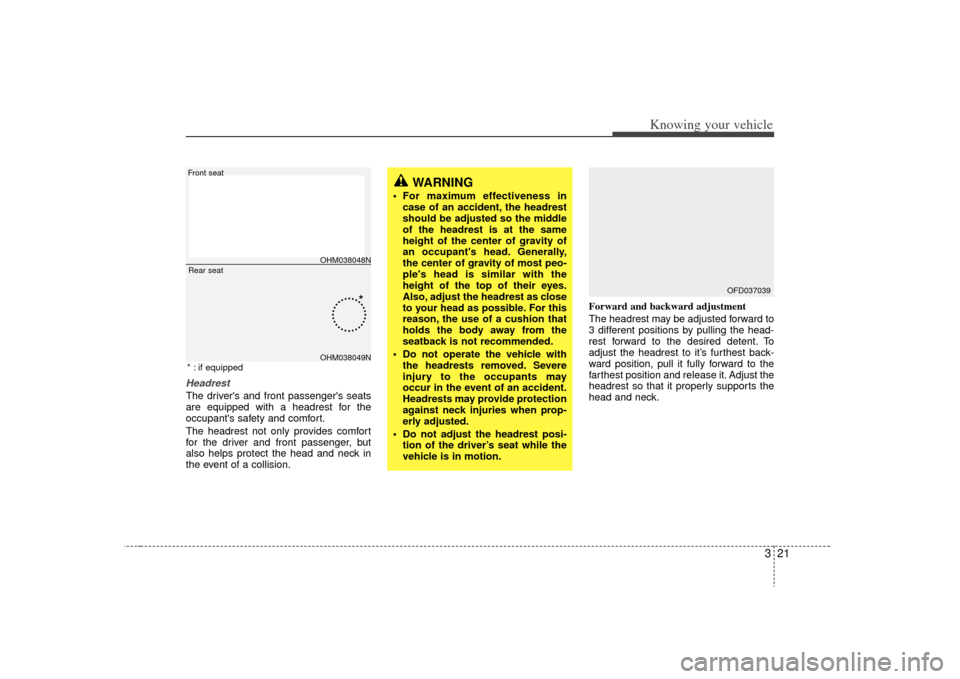
321
Knowing your vehicle
HeadrestThe driver's and front passenger's seats
are equipped with a headrest for the
occupant's safety and comfort.
The headrest not only provides comfort
for the driver and front passenger, but
also helps protect the head and neck in
the event of a collision.Forward and backward adjustment
The headrest may be adjusted forward to
3 different positions by pulling the head-
rest forward to the desired detent. To
adjust the headrest to it’s furthest back-
ward position, pull it fully forward to the
farthest position and release it. Adjust the
headrest so that it properly supports the
head and neck.
OHM038049N
WARNING
For maximum effectiveness in
case of an accident, the headrest
should be adjusted so the middle
of the headrest is at the same
height of the center of gravity of
an occupant's head. Generally,
the center of gravity of most peo-
ple's head is similar with the
height of the top of their eyes.
Also, adjust the headrest as close
to your head as possible. For this
reason, the use of a cushion that
holds the body away from the
seatback is not recommended.
Do not operate the vehicle with the headrests removed. Severe
injury to the occupants may
occur in the event of an accident.
Headrests may provide protection
against neck injuries when prop-
erly adjusted.
Do not adjust the headrest posi- tion of the driver’s seat while the
vehicle is in motion.
Rear seat
OHM038048N
Front seat
*
* : if equipped
OFD037039